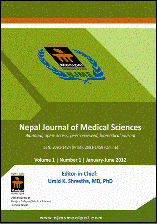Outcome of Extracorporeal Shock Wave Lithotripsy in Western Region of Nepal
DOI:
https://doi.org/10.3126/njms.v1i1.5787Keywords:
ESWL, renal stones, ureteric stonesAbstract
Background: Extracorporeal shock wave lithotripsy (ESWL) is an effective non-invasive method for management of urinary tract stones. It was introduced for the first time in Pokhara 1 year back. This study aims to study the efficacy of ESWL in removal of renal and ureteric calculus in relation to the stone size and location and potential adverse effect of the procedure.
Methods: It is a prospective observational study carried out in 112 cases undergoing elective ESWL for solitary urolithiasis during a period of 1 year (August 2010- August 2011). Number of sessions required for successful fragmentation and clearance of stones were studied according to their size and position along with the complications encountered.
Results: The success rate of ESWL was found to be 91.1% for solitary urolithiasis. The mean number of sessions required for success was found to increase according to increase in size of the stones whereas it was almost similar for various locations. Complications were encountered in 25% of cases.
Conclusion: Stone size was found to be the most important predictor in successful outcome of ESWL and the procedure is quite favorable for stones less than 20 mm.
Keywords: ESWL; renal stones; ureteric stones
DOI: http://dx.doi.org/10.3126/njms.v1i1.5787
Nepal Journal of Medical Sciences. 2012; 1(1): 3-6
Downloads
Downloads
How to Cite
Issue
Section
License
Copyright © by Nepal Journal of Medical Sciences. The ideas and opinions expressed by authors of articles summarized, quoted, or published in full text in this Journal represents only opinions of authors and do not necessarily reflect the official policy of Nepal Journal of Medical Sciences or the institute with which the author(s) is (are) affiliated, unless so specified.




